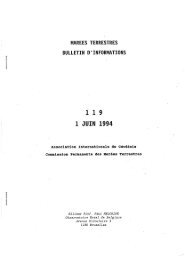marees terrestres bulletin d'informations - Université de la Polynésie ...
marees terrestres bulletin d'informations - Université de la Polynésie ...
marees terrestres bulletin d'informations - Université de la Polynésie ...
You also want an ePaper? Increase the reach of your titles
YUMPU automatically turns print PDFs into web optimized ePapers that Google loves.
is done with an optical lever using a small mirror mounted on the weight. Using this mechanical-optical<br />
extensometer, Sassa first succee<strong>de</strong>d to observe the tidal strain changes of the Earth in Ikuno and Makimine<br />
stations in 1943. Accordingly, the experimental investigation of the strain-tensor components of Earth ti<strong>de</strong>s<br />
started. Sassa and Ozawa installed the same type extensometer in Osakayama Observatory in 1947 and<br />
continued long-term tidal strain measurements. They first reported these result of tidal strain measurements at<br />
the IAG General Assembly held in Brussels in1951 (Sassa et al.(1952) and Ozawa (1952)).<br />
Izuo Ozawa <strong>de</strong>vised many kinds of mechanical extensometers with photographic recording systems.<br />
Figure 7 shows a high-sensitive super-invar bar extensometer with magnifier of Zollner suspension type<br />
(Ozawa, 1961). He continued precise tidal strain measurements in Osakayama, Kishu and Suhara in Japan<br />
over many years. In 1971, a super-invar bar extensometer of Ozawa type was installed in the Walferdange<br />
<strong>la</strong>boratory in Luxembourg (Ozawa et al., 1973). This instrument was used to estimate the l/h ratio (Melchior<br />
and Ducarme, 1976).<br />
Figure 7. Schematic representation of a super-invar bar extensometer with magnifier of Zollner suspension<br />
type <strong>de</strong>signed by I. Ozawa (left) and example of tidal strain records (right).<br />
A continuous monitoring of crustal movements by tiltmeters and strainmeters has been consi<strong>de</strong>red to be<br />
an effective measure of earthquake precursors particu<strong>la</strong>rly on short time scales of hours to days. An early<br />
contribution in such an approach was due to Sassa and Nishimura (1951). They first reported anomalous<br />
changes of ground-strains and tilts observed before occurrences of some <strong>de</strong>structive earthquakes at<br />
observatories located near the source regions. Among them, a typical example was a precursory tilting motion<br />
associated with the 1943 Tottori earthquake of M=7.2. During 6 hours prior to the occurrence of the<br />
earthquake, an anomalous tilting motion with the or<strong>de</strong>r of 0.1” (0.5 μ rad.) was observed with a tiltmeter of<br />
the horizontal pendulum type installed at 800m un<strong>de</strong>r the ground surface in Ikuno mine located about 60km<br />
away from the epicenter. Although there remained some uncertainties to conclu<strong>de</strong> it as a precursor, it p<strong>la</strong>yed<br />
an important role in Japan for promoting the national project for earthquake prediction which started in 1965.<br />
Since then, many observatories and supplementary stations for monitoring crustal movements have been<br />
established in Japan. More than 100 stations are operating un<strong>de</strong>r the national project for earthquake prediction.<br />
Despite such a <strong>de</strong>nse arrangement of stations equipped with improved instruments, we have not been able to<br />
<strong>de</strong>tect “reliable precursors” immediately before the occurrence of earthquakes.<br />
In the early morning of January 17, 1995 (in Japanese Standard Time), a <strong>de</strong>structive earthquake of<br />
M w =6.9 occurred near the Kobe City. The <strong>de</strong>ath toll from the earthquake reached more than 6,300 due to<br />
col<strong>la</strong>pse of buildings and bridges, fires and diseases induced by the earthquake. We have carried on<br />
continuous observation of crustal strains with a <strong>la</strong>ser strainmeter at the Rokko-Takao station in Kobe since<br />
1989 (Takemoto et al., 1998b, 2003). The distance from the station to the epicenter is about 20 km and the<br />
station is located almost above the fault p<strong>la</strong>ne. Based on the <strong>la</strong>ser strainmeter data, we searched for anomalous<br />
strain changes before and after the earthquake mainly focusing to the period of one week before the<br />
11772



